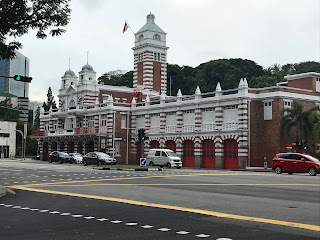25 November 2017. Fort Canning Park
I had missed out on Fort Canning last time and decided to make amends. On the way, I passed the old Fire Station that is now a museum.
It was striking for the emphasis that Singapore places on civil defence - partly because of the risk of tornadoes.
Fort Canning is on a hill that had been the site of rulers of the Singapore region over the centuries. For a long time, under Malay rulers, it was forbidden to the citizens. Then, under the British, Raffles had a bungalow built for himself.
It gives commanding views of the city and harbour and for that reason, was the site of a lighthouse, signal mast and time ball.
There is a variety of trees, all carefully labelled and described in what is now a very pleasant park.
The hill was the site of the British military 'Battlebox' in the war.
To see inside, it is necessary to join a tour but this was very informative and not the typical useless information sort of tour. The guide took us through the decision to surrender on 15 February 1942 and its consequences. It appeared that the British were hopelessly overstretched and despite outnumbering the Japanese in terms of men, they were hopelessly inadequate in terms of ships (all two sunk very quickly), tanks (none) and aircraft (fewer than the Japanese and some going back to the first world war).
 Outside again, I carried on walking through the park and wandered down to the City Museum. On the way, I came across some jolly statues.
Outside again, I carried on walking through the park and wandered down to the City Museum. On the way, I came across some jolly statues.

The museum was having a Grandparents' Day which gave it an animated atmosphere.
Inside, the lessons of the war and life under the Japanese were repeated and hammered home.
It was striking for the emphasis that Singapore places on civil defence - partly because of the risk of tornadoes.
Fort Canning is on a hill that had been the site of rulers of the Singapore region over the centuries. For a long time, under Malay rulers, it was forbidden to the citizens. Then, under the British, Raffles had a bungalow built for himself.
It gives commanding views of the city and harbour and for that reason, was the site of a lighthouse, signal mast and time ball.
There is a variety of trees, all carefully labelled and described in what is now a very pleasant park.
The hill was the site of the British military 'Battlebox' in the war.
To see inside, it is necessary to join a tour but this was very informative and not the typical useless information sort of tour. The guide took us through the decision to surrender on 15 February 1942 and its consequences. It appeared that the British were hopelessly overstretched and despite outnumbering the Japanese in terms of men, they were hopelessly inadequate in terms of ships (all two sunk very quickly), tanks (none) and aircraft (fewer than the Japanese and some going back to the first world war).
 Outside again, I carried on walking through the park and wandered down to the City Museum. On the way, I came across some jolly statues.
Outside again, I carried on walking through the park and wandered down to the City Museum. On the way, I came across some jolly statues. 
The museum was having a Grandparents' Day which gave it an animated atmosphere.
Inside, the lessons of the war and life under the Japanese were repeated and hammered home.
In the evening, I set off to discover the Old Airport Road food centre that was highly recommended in TripAdvisor. It did not disappoint and I had a delicious Dory fish that I failed to photograph.












Comments
Post a Comment